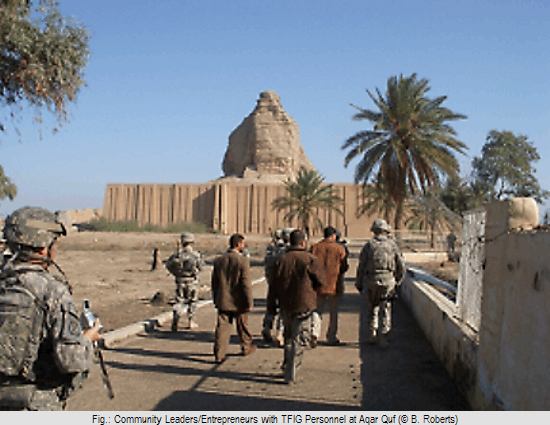Stability and Support Operations (SOSO) and Civil-Military Operations (CMO) call for strategies for both cultural heritage preservation practices and economic development activities. The U.S. Army's CERP was developed in Iraq in 2003 to allow rapid response to localized problems at the lowest level possible. CERP provides opportunities for the local populace to obtain steady employment while at the same time encouraging shared cultural heritage identity through the protection of cultural heritage sites.
Many Iraqi small businesses and microenterprises were seriously disrupted as a result of the United States invasion in 2003. Over the course of the past 6 years the United States Army has been tasked not only to provide security, but to also participate in rebuilding much of the infrastructure of Iraq.
Status of Forces Agreements (SOFAs) in a Counterinsurgency (COIN) environment have a major impact on cultural heritage resource protection and related small business development. In the context of what the military calls Stability and Support Operations (SOSO) and Civil-Military Operations (CMO), strategies have been developed to support cultural heritage preservation work and economic development.
CERP monies and similar initiatives are key components of a successful COIN operation. Providing opportunities for the local populace to obtain steady employment while at the same time encouraging shared cultural heritage identity through the protection of cultural heritage sites is a classic win-win scenario.
The US Army's Commander's Emergency Response Program was developed in 2003 to allow rapid response to localized problems at the lowest level possible. "CERP originated as a stabilizing tool that commanders could use to benefit the Iraqi people [1]." By 2008 over $500 million dollars annually was allocated to the program. The amount of money spent in Iraq for CERP in 2009 was more than Congress authorized for the entire U.S. Small Business Administration budget that year.
"In late 2008 I was a liaison between the 926th EN BDE and the 1/21 IN for a roughly three-week period. Among the many community development projects I worked on, the most interesting one I assisted in scoping was the possibility of improving the tourism infrastructure around the Ziggurat at Aqar Quf." The site had once enjoyed tourists from all around Iraq and abroad and it was obvious that Iraqis had worked to preserve much of the ziggurat and surrounding structures.

Lessons Learned
[1] M. S. Martins, “The Commander’s Emergency Response Program,” Joint Force Quarterly, Issue 37, 2nd Quarter, 2005, p. 47.
Conclusion
Through the creation of employment opportunities and economic stability, CERP projects address a key issue in U.S. Army's Counterinsurgency Field Manual; "Fighters who have joined for money will probably become bandits once the fighting ends unless there are jobs for them" [2].
The future of heritage training in the military should be focused on what a former Battalion commander of mine called "strategic privates" [3], meaning that even the lowest ranking soldier on the battlefield can make decisions that have great strategic significance, especially in this day and age with twenty-four hour media coverage.
The CERP model is perfect for the inclusion of cultural resource protections practices in addition to community development goals. As the U.S. continues to conduct contingency operations globally, these programs should and will become mainstays of military strategy.
[2] F· U.S. Army Field Manual, Counterinsurgency (FM 3-24), Headquarters, Department of the Army, December, 2006, Paragraph 1-45, p. 1.9.
[3] Personal communication: Hargett, Lieutenant Colonel Joe, "Strategic Privates", Battalion Commander, 890th Engineer Battalion (MS Army National Guard), 926th Engineer Brigade, Multinational Division, Baghdad, Iraq, OIF 08-10.
![]() © Benjamin A. Roberts
© Benjamin A. Roberts
e-mail: benjamin.a.roberts@us.army.mil
This article should be cited like this: B.A. Roberts, A Case Study in Cultural Heritage Protection in a Time of War. The Ziggurat at Aqar Quf, Forum Archaeologiae 55/VI/2010 (http://farch.net).